Distance: 7 nm (engine test)
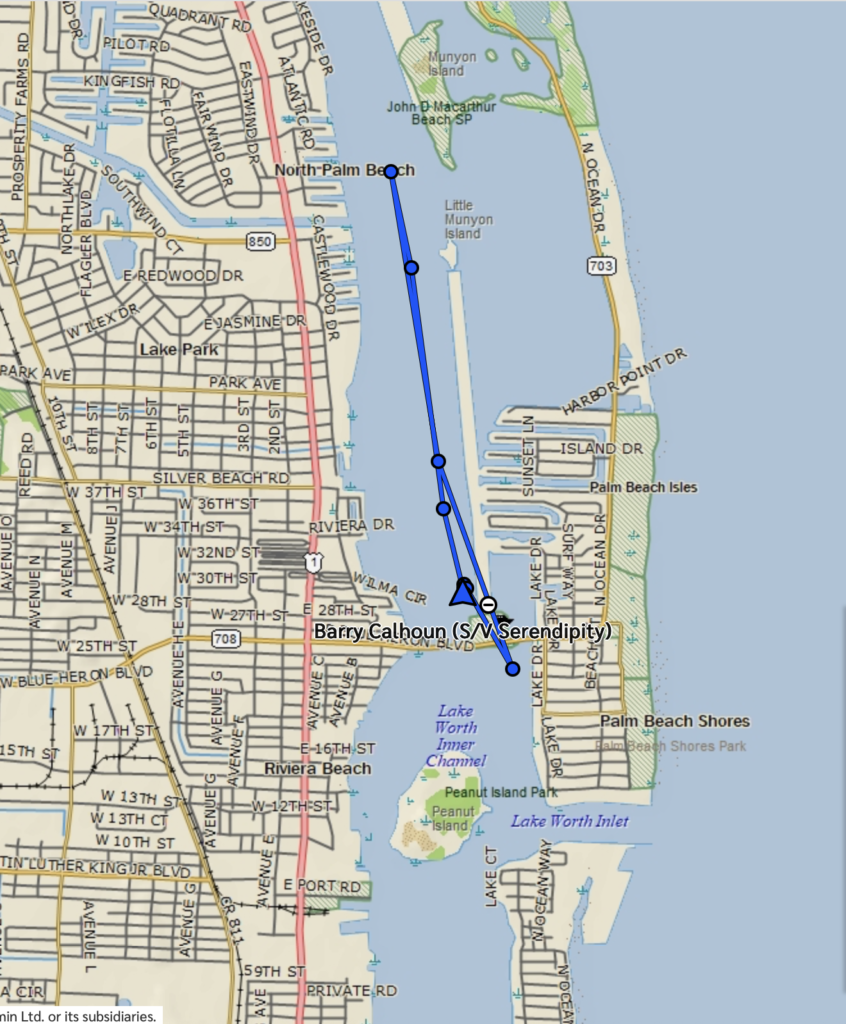
I ended up spending another four days at anchor off Singer Island in Riviera Beach. It proved a pretty convenient anchorage, thanks to the boat ramp at Phil Foster Park where dinghies could be tied up. In my case, though, because I had already stowed my dinghy and planned to go outside for my next leg, I would use my paddleboard to make my three trips ashore.
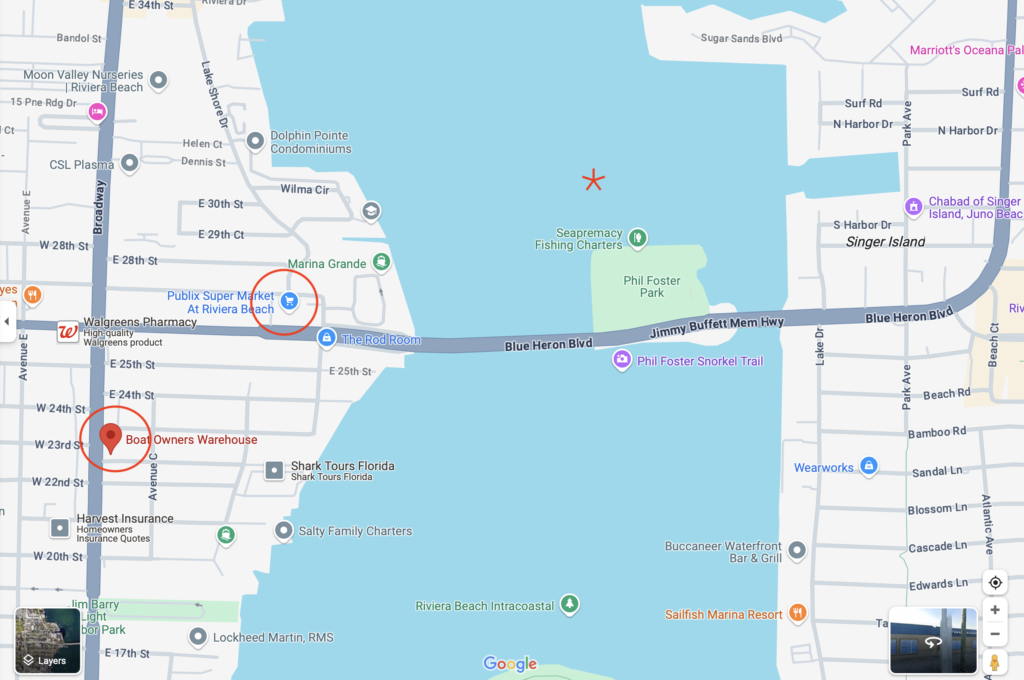
From Phil Foster Park, it was a 1/2 walk over a very scenic bridge to Publix, a laundromat directly across from it, and another wonderful Boat Owners’ Warehouse. I took advantage of all three of these over the next few days.
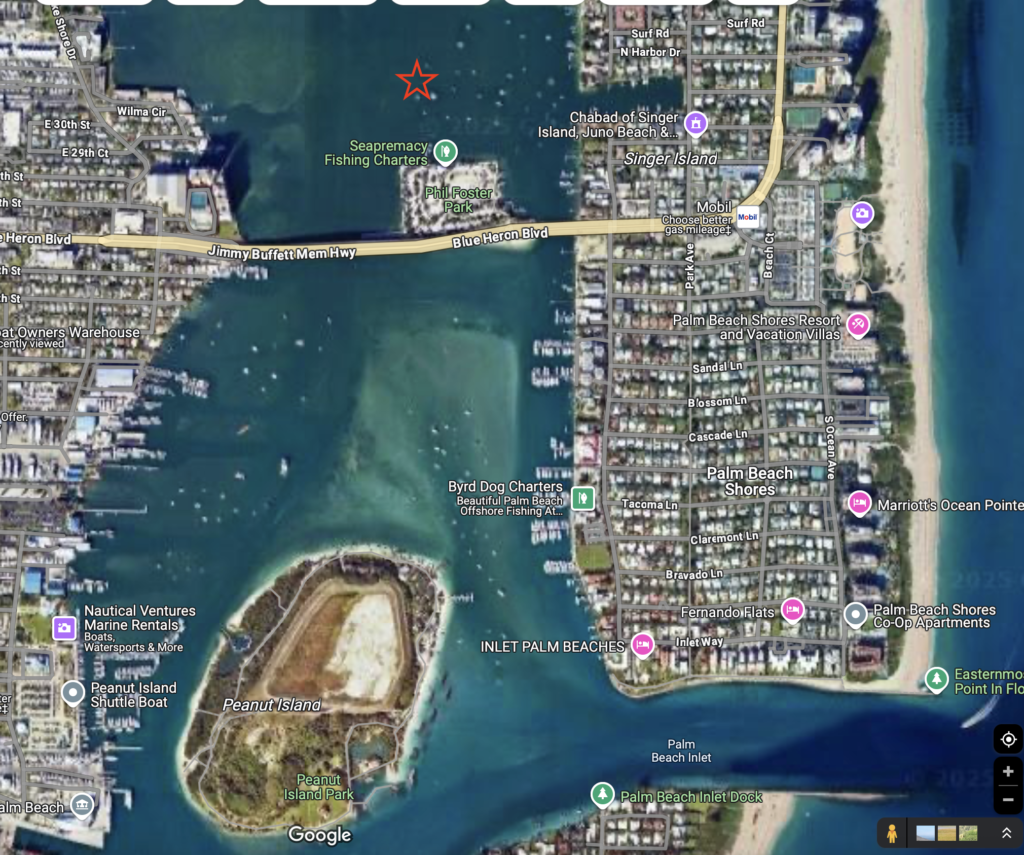
But my main goals were to clean my hull and figure out what was going on with the engine. Over the next four days, I dove on the boat. It was wonderful to actually be able to see everything (and the water was noticeably warmer). Even though I had cleaned it (by touch) only a week before, there was already (still?) a lot of growth on it. I don’t know if this was because the fouling had gotten to bad in the St. Lucie River in Stuart, or if I had just been doing a bad job because I couldn’t see anything. Regardless, it took me four days to get it spotless.
In the meantime, I had decided to run some Barnacle Buster1 through the engine. I had been meaning to do this for a couple of years, but never tackled the project because getting the Barnacle Buster into the engine would require some plumbing changes in the engine raw water system, but other projects had already taken priority. But it now seemed like this was the only thing within my capability to try, and I though it might prove successful. But, I somehow had to introduce the Barnacle Buster solution into my engine’s raw water system. The idea I had had for a couple of years was to install a y-valve just upstream of the through hull seacock to which I would attach a garden hose. The hose would be set in a bucket of Barnacle Buster, the engine started, sucking the bucket dry, and then the engine shut off overnight to allow the Barnacle Buster to do it’s thing. I also planned to make the garden hose long enough to reach down into my bilge to use the engine as an emergency bilge pump should the need ever arise. But this would actually be a lot of work, complicated by the lack of space in the compartment where the seacock was. This was one of the reasons I had put it off.
But, the next day, Friday, as I reviewed the Barnacle Buster directions, including watching some YouTube videos, I came across a savior! A cruising couple had posted an instructional video and were talking about some kind of adapter cap they used to attach a garden hose directly to the raw water strainer. Sure enough, recognizing the need, the same company who made Barnacle Buster made raw water strainer caps which had a garden hose adapter on the top. You simply unscrew the normal strainer lid, screw on the proprietary, engine flushing one, and attach a garden hose to it. The other end of the hose goes into the bucket of Barnacle Buster, the engine started, etc. So simple!
But, I had neither one of these caps nor a spare garden hose, (or, come to that, any Barnacle Buster!) This is when I discovered that there was one of these Boat Owners Warehouses 1/2 mile away. A quick phone call confirmed that they had all three! Score!
But, it was already getting into the afternoon, I hadn’t deployed the paddleboard yet, and wanted to dive on the boat, and so spent the rest of the afternoon cleaning the first quarter of the hull.
The next morning (Saturday), I deployed the paddleboard, paddled 1/4 mile to the park, hid the paddleboard in some bushes, walked across the bridge to the Boat Owners Warehouse to pick up the engine flushing supplies, stopped at Publix on the way back to pick up some produce, then paddled back to the boat (challenging with all the wakes from the boats!). After cutting the new garden hose to an appropriate length and diluting the Barnacle Buster in a 5-gallon bucket, I ran the engine until the bucket was almost empty, turned it off, and removed all the equipment to let it sit overnight. By this time it was afternoon and I commenced my second, bottom-cleaning dive on the boat.
On Sunday morning I ran the engine for awhile to flush out the Barnacle Buster (and hopefully a lot of now-disintegrated calcium buildup), then decided to weigh anchor and take it for an hour-long sea trial to see what affect the flushing had on the engine temp. Boy, not the best day to try this, on a Sunday. It was so crowded that it was stressful just trying to get into the ICW with so many boats coming and going from every direction.
I initially had decided to kill two birds with one stone by heading south towards the Lake Worth Inlet to check it out in the daylight since I would likely be departing in the middle of the night when I finally went offshore. There are two channels that go around Peanut Island, the main channel to the southwest of the island, and another, smaller, shorter one that goes around the northeast side. For the sea trial to be valid, I felt I needed to be at cruise RPM for about an hour. That meant motoring for 30 minutes out and 30 minutes back. I thought I’d be able to do at least one lap around peanut island, checking out both channels while checking out my newly-flushed engine cooling system.

What a mistake! While I had seen the weekend traffic passing by in the ICW the day before, I had no idea what I would encounter once I got south of the bridge and to Peanut Island. Holy cow! Hundreds of boats criss crossing, going every direction. I was frequently having to stop and start to avoid hitting them, accelerate as quickly as possible to get between others, and so on. It was even difficult to stay in the middle of the channel where my draft required because of all the boats coming the other way right in the middle. It was a nightmare! I made it about 1/2 mile around the northeast side of Peanut Island before I said, “F*%k this!”, did a 180, and zig-zagged my way back to the north side of the bridge where I continued north in the ICW for 30 minutes. Even that was challenging because of the boats zipping around on all sides. There was so much traffic that it took me about five minutes of waiting before I could time my 180-degree turn back south in the ICW without hitting anyone! But I finally made the turn and then another back into the anchorage, dropping the hook around 2 pm.
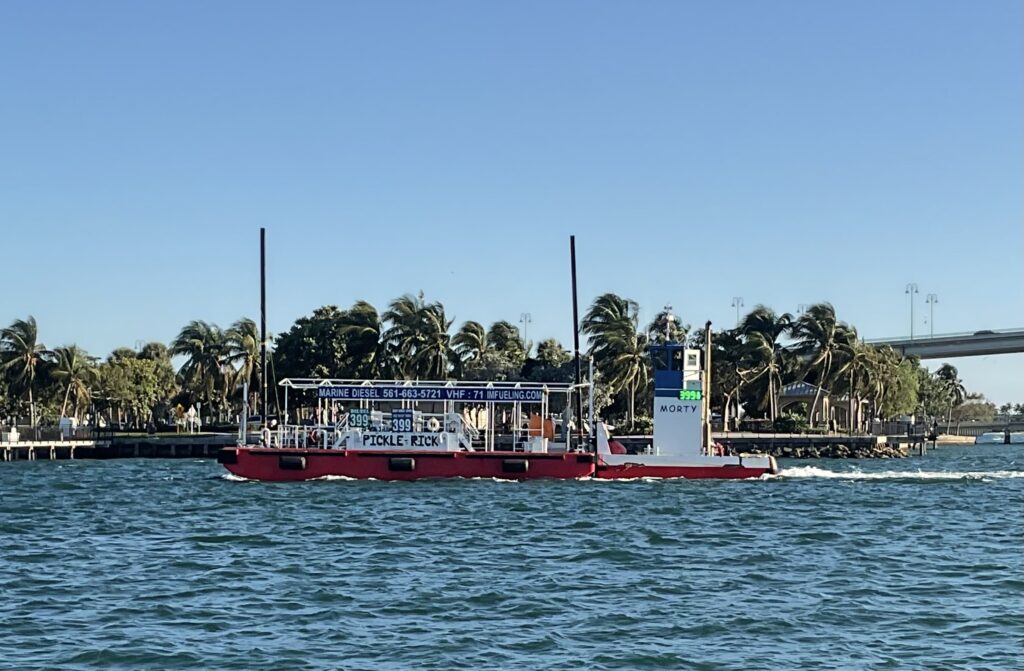
The result of the flushing seemed to be a whopping 5-degree drop in engine temperature at cruise, from 190 to 185. That was still above normal (180), but I felt I could live with it. I guess Barnacle Buster had done all that it could. What remained was to replace/clean the exhaust elbow and/or the heat exchanger. I felt that further troubleshooting could wait until I got to the Keys, and so decided that I would head offshore for Key Biscayne at the next weather window, which was supposed to be in a couple days.
I had been texting Bill Obermeyer and my son, Nicholay about the persistent overheating issue, even after flushing the raw water system. They both thought that perhaps my engine raw water through hull was partially clogged with barnacles or other growth and that I should remove the clam shell strainer cover over it on the outside of the hull to reach in there with a screwdriver to make sure it was clean. This was something I felt I could do once I got settled in the Keys.
While this anchorage had been very convenient, it had one huge drawback: The no-wake zone under the Jimmy Buffet Highway Bridge ended a few hundred yards before the Singer Island Anchorage. That meant that all the boats were either on plane or transitioning as they passed the anchorage. It was very rough–definitely the roughest wakes I’ve experienced in an anchorage. Especially bad were all the huge sport fisherman coming and going all day. They would often generate a 3-foot wake which would throw me across the cabin and knock things off my shelves if I wasn’t expecting them. I even lost about $100 of bottom cleaning tools off the deck after getting hit by a wake. Luckily, the nights were calm, but the days were bad, and the weekend days atrocious. As many of the reviews had stated about the anchorage: It was convenient but very uncomfortable.
Two days before I departed, a work boat came out and started mounting a nautical sign on the day marker denoting the ICW just west of my boat. I was all excited because I figured someone had finally gotten wise and extended the no wake zone past the anchorage, which would give me at least a couple days of respite from the huge and frequent wakes. But, it turned out to only be a caution about Manatees on the other side of the channel. Psyche! 🙁
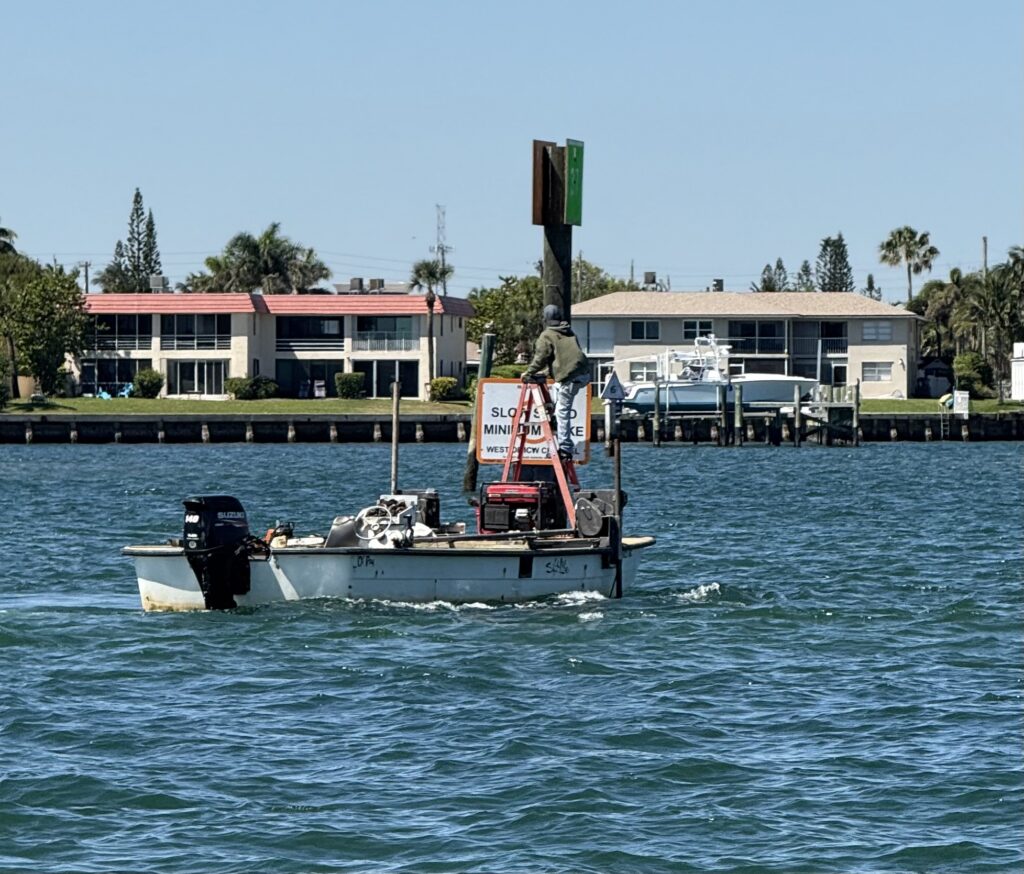
I finished up Sunday with the third quarter of the bottom cleaning. On Monday I finished the hull and went back ashore to do some final grocery shopping and laundry before perhaps being somewhere at anchor in the Keys for an extended period of time.
The plan for Tuesday was to take the paddleboard to shore one more time to top off my freshwater jerry cans (which I use mostly for showers and giving a freshwater rinse to my dive gear), and then try to take a nap in the afternoon. A weather window had appeared making a midnight departure look good for an offshore passage past West Palm Beach, Fort Lauderdale, Hollywood, and Miami to an anchorage in Key Biscayne. It was going to be a very long night, not being able to sleep, but I felt it worth doing. And this time, it wasn’t going to be cold during the night, with temps in the 70’s and light winds; I would be motoring the entire way.
That plan went well except for a slight mishap when departing the boat. I had tied my two empty water Jerry cans to the paddleboard in case I capsized and was setting off from the boat when the wind started pushing me into the boat as I reached the stern. To avoid bumping, I reached out to push off the outboard which was mounted on the stern rail. Unfortunately, I pushed against the propeller, which promptly spun out of my hand, causing me to loose my balance and plunge head first into the water! Of course, whenever on the paddleboard, I am prepared to go in the water and this was no exception, so I just climbed back aboard, pulled the floating Jerry cans back on top, and continued on my way. It actually felt pretty good in the heat.
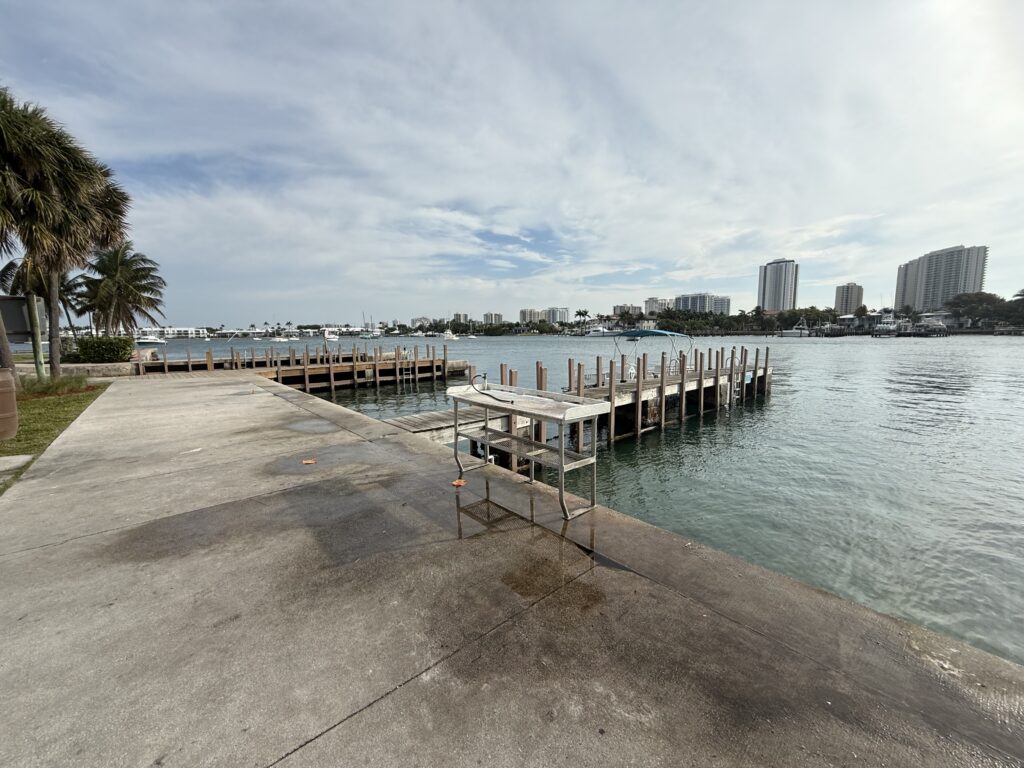
The rest of the journey went well, although balancing 70 lbs worth of Jerry cans in the middle of a paddleboard in one-foot seas was challenging, as was getting them up over the gunwhale without capsizing when I got back to Serendipity. Nothing is every simple on a boat!
- Barnacle Buster is a product that dissolves calcium and similar buildup in engines (and other things). It can either be rigged to flush constantly through a closed-loop system set up for an engine, or introduced into the raw water system and left to soak overnight. The idea is that if there is marine calcium buildup in the cooling system (i.e., from barnacles), then Barnacle Buster eats them away. Running the engine then flushes out of the dissolved calcium, freeing up the clogged passages and allowing the cooling system to be more effective. ↩︎